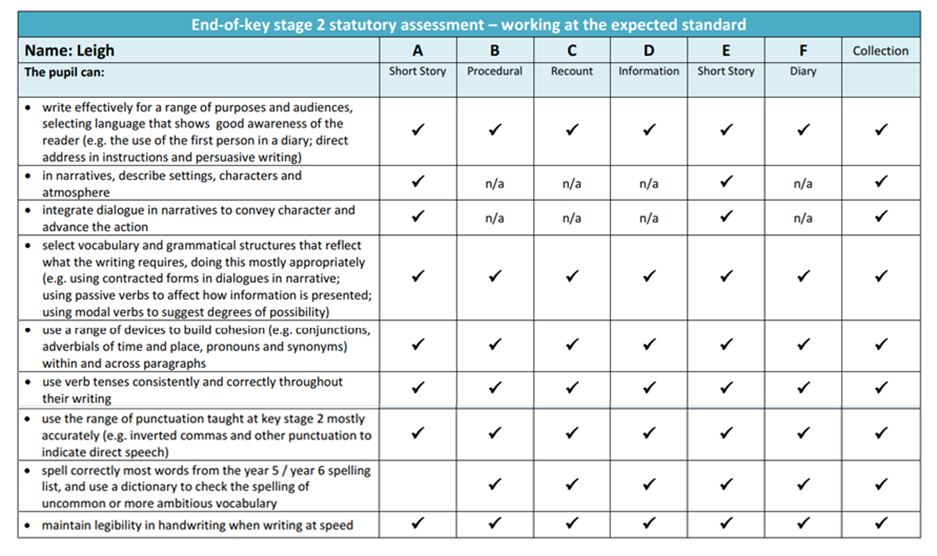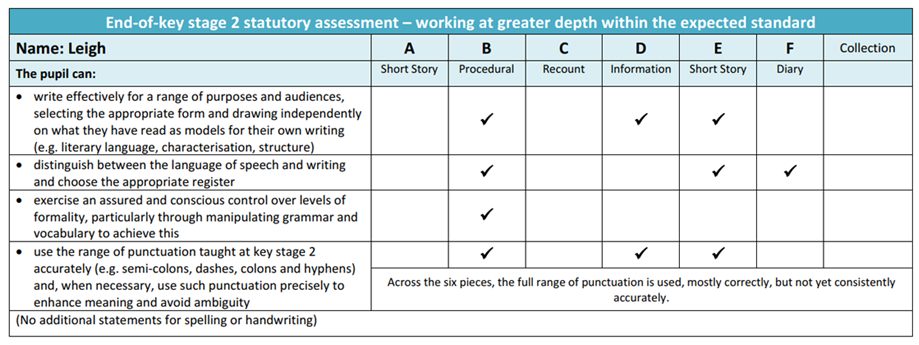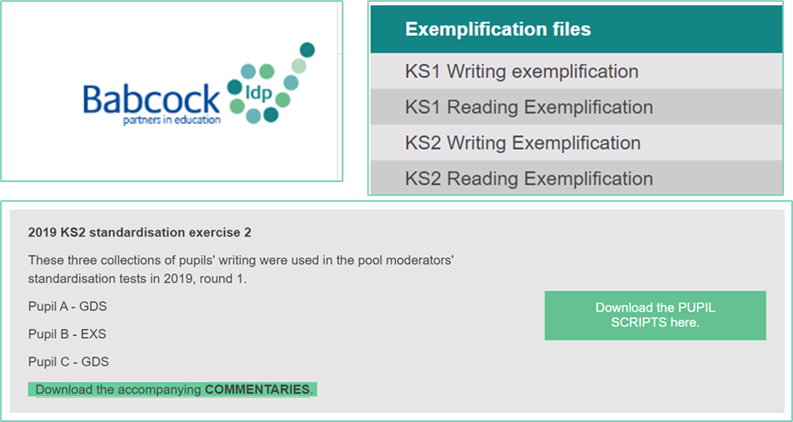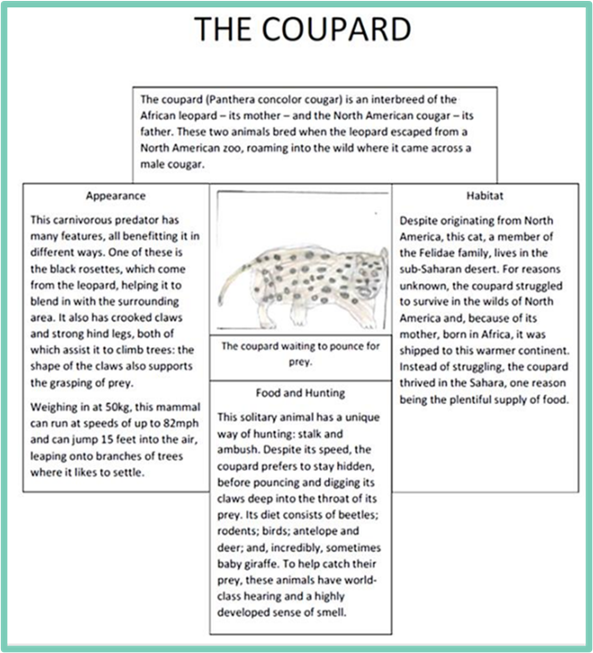
This is not an ideal time for a blog about end of KS2 statutory writing assessment. It’s the week after SATs for one thing. So, this blog is deliberately geared towards the immediate weeks ahead. It’s clear from so many conversations, across so many schools, that quick win advice might go down well right now. For some, addressing gaps caused by pandemic disruptions remained a priority up until recently. It’s hardly surprising that talk has been of expected drops in the numbers achieving GDS standard in writing. Still, there have been a number of requests for support in identifying writing opportunities that might be helpful in the final stretch of the assessment window.
This blog aims to provide some guidance along those lines. It does not reflect our wider views and approaches to developing reader-writers. It’s a deliberately short term and strategic look at primary writing with a particular aim in mind. It’s also an attempt to take some of the weight from our year 6 colleagues’ shoulders in what has been another challenging year. Under 'normal' circumstances, this time of year for the Year 6 teacher, especially the new-to-year-6 teacher, is seared into my own teaching memory. It can feel lonelier than it should, no matter how many times you might be told “You’ve got this”, no matter how healthy an outlook we might have on the place and nature of statutory KS2 assessments.
So, without any apologies, I’ll crack on with some targeted advice and helpful links.
The blog has three sections:
- section 1 looks at examples of pupil’s writing from the STA and highlights a broader view of what might constitute GDS writing. I think this might be most useful in relation to nudging possible borderline cases, and for some quick win writing opportunities in the run up to the close of the assessment window
- section 2 offers links to four evergreen, hugely helpful blogs from our Assessment Team (@HertsAssessment) colleagues, offering practical guidance related to writing moderation and the TAFs
- section 3 gathers links to my earlier blogs on the topic of GDS writing for those that have joined Twitter/become familiar with our blogs more recently. These offer further writing opportunities
1. In search of a benchmark: widening writing exemplifications
1a. Core exemplifications
Just briefly, let’s remember Frankie in all this. Frankie the ‘epitome’ of GDS.
Frankie stands as the one-and-only STA exemplification of writing judged to be representative of GDS for writing. My relationship with Frankie’s writing efforts rivals some of my friendships in terms of how often we get to interact. In recent weeks, we’ve become aware of newer teachers/year 6 returners that are not familiar with this bank of work.
For those not familiar, it’s essential reading under the current system. If you haven’t before, read the work and the associated commentaries, focusing on the most useful, perhaps less florid parts. This will give you a common reference point with year 6 teachers across the country. You can find it here:
Keep in mind this statement from the opening of the exemplification files:
"Exemplification materials illustrate only how 'pupil can' statements in the frameworks might be met. They do not dictate a particular method of teaching, or the evidence expected from the classroom, which will vary from school to school. "
The word 'might' is important here – Frankie is one manifestation of the standard, not a definitive model. This is good news. Otherwise, we’d all best enrol our children in ballet classes at the earliest opportunity.
Reading each piece and considering the most useful parts of the commentaries can help us to keep in mind aspects of writing that we might want to draw attention to when working with the most assured writers. Exemplification banks, without the commentaries, can also offer some useful opportunities for focused reading for our children to see the work of others and consider what they like/dislike and how they would have gone about a similar task. This can add further layers to awareness of the limitless networks of choices that writers have at their disposal.
I used the plural ‘exemplification banks’ deliberately. Turning to one of the EXS exemplifications might help Frankie seem a little less lonely.
Meet Leigh, handily remembered as Near-Leigh GDS Leigh. My former colleague Clare Hodgson, our then moderation lead, wrote about Leigh’s work and how it might offer more helpful hints in an earlier blog for the assessment team.
Take a read of this helpful snippet in which Clare flags some learning relating to bullet 3 of the GDS statements. I’d thoroughly recommend reading the whole of this immensely popular blog.
Obviously, writing such as 'Frankies' clearly meets this statement - but how 'assured and conscious' do our Y6 writers need to be? Here it is worth turning to the 'Leigh' exemplification file as a benchmark as Leigh only narrowly misses the greater depth standard. There is one piece - piece B - where Leigh is able to meet the 'assured and conscious control' statement. The annotations on the remaining pieces show where Leigh has been less consistent and hence why the award remains at expected standard.
Reflect too, as you read the collection, on the purpose and audience for each piece in the collection. Are there enough opportunities for Leigh to write formally? Could more opportunities for formal writing have helped? Does the recount provide any evidence for Greater depth? (No!) Additionally, has Leigh been given adequate time to re-draft some sections of his/her work to consider precision of language, or tidy up punctuation? The implications are that greater depth writers may need longer to craft their writing, as well as more exposure to a range of reading material and a range of tasks that have clearly defined purpose and audience.
Leigh’s writing is offered as one of two banks that exemplify writing demonstrating sufficient evidence of the requirements for a judgement of EXS, but was evaluated as stronger than their fellow EXS-achiever Morgan. Towards the end of each bank there is a tick-grid showing which pieces meet which bullet point in each standard. Here’s Leigh’s tally sheet for the EXS statements. If it was a game of bingo, you’d be getting excited:

It's almost a clean sweep. Bullet two and three relate to narrative features and are demonstrated sufficiently well in two pieces to secure an overall nod of approval for those two statements, as shown by the tick in the final column. Piece A did not offer evidence of the EXS spelling list statement, but given that every other piece does, it’s no wonder that that statement is also judged to be fully met.
Nice work Leigh. So let’s give the GDS bullets a quick once-over.

Back to our imagined game of bingo. It’s far from a full house but Leigh does manage to get a complete line of ticks for Piece B (third column) and a close-to-complete line for piece E (sixth column).
It’s by looking at these pieces that we can begin to broaden our view of the nature of writing that might support a judgement of GDS. Frankie is a very particular, ballet-obsessed writer who may well skew judgements towards a very secure bank of evidence demonstrating the standard. Leigh is a very particular, different kind of writer, offering pieces that might draw closer parallels with the writing produced by your children. In piece B, we have something that we might fairly characterise as 'very recognisably primary school writing'. It’s writing that with the right inputs, we might see from confident Year 4 writers. Here its labelled as procedural; for our purposes I am going to call it Very Fancy Instructions. Take a look, read the piece, read the commentaries, and consider how you might apply some of those pointers to writing from your own curriculum. It’s a style of writing that is likely very familiar to your young writers. Might Piece B offer some inspiration for some instructional writing based on rich, well-known content?
Piece E, a retelling of Jack and the Beanstalk in something like the Star Wars universe, meets all but bullet 3 (as discussed by Clare above). Once again the commentaries are instructive and acknowledge some strengths in the manipulation of grammar, and some indications of why it doesn’t quite hit the spot. Might this be useful in revisiting earlier narrative writing with a view to some targeted editing with that bullet point in mind? Further developing the literary language used in a piece, moving beyond structures more typical of day-to-day speech will likely pay dividends. Giving children the chance to revisit earlier writing with a more mature eye can make all the difference and is a perfectly legitimate writing activity. Writers revisit old work; writers put down a project and pick it up later, with fresh, or older, wiser eyes. Your writers shouldn’t be any different – and that really can be a very quick win. It’s also immensely gratifying for children to appreciate for themselves their own progress and growth as writers in their time with you. Revising earlier pieces will provide an opportunity for this, as well as a further lesson that writing is something to be crafted over time, not just within the context of a single lesson or unit.
1b. Lessons from moderation materials

Besides Leigh’s writing, there are further samples to draw from in the collections used in Lead moderator/moderator standardisation exercises. These can be found in various locations, but our friends at Babcock offer up a beautifully well-organised webpage gathering them all together for very easy access. Thank you Babcock – this has been so useful in terms of its clear layout.
Please do me a quick favour, to help with orientation, if this is new to you:
- follow this link - Devon County Council: KS2 Pupil Writing Collections (previously Babcock)
- scroll down slowly enough to count the number of collections judged at GDS
I make it nine. Nine is better than one. Include Leigh here and we have nine-and-a-bit. Frankie is no longer the singular star in a GDS solar system. We’ve got a galaxy of pointers, all with commentaries and some really nice pieces to broaden the horizons of all three standards.
Let me direct you to 2019 KS2 standardisation exercise 2 and take a look at Pupil C’s work, judged as meeting GDS. This one gave a number of moderators pause for thought. It has many nice touches, but it has its shaky moments. Here’s a top tip: if you are ever unsure whether a bank represents achievement at EXS or GDS, read it out loud. It really helps. Try reading some of Pupil C out loud. You’ll pick up on some less confident stretches, minor lapses, and moments where they seem to become somewhat locked into a groove, unsure of where to go next.
This writing is officially judged to have indicated a higher achievement than Leigh’s but I also think it offers a less intimidating vision of what GDS might look like. Some evidence banks scream GDS almost instantly. They are just plainly, obviously GDS through and through. That's arguably less useful in terms of mapping out the standard, and certainly not so useful in helping us make a call on borderline cases.
From this bank, and again like Leigh, take a look at the pieces that stand out as fairly common primary writing tasks, for example Piece B, the science investigation. Familiarity is helpful. What do they do there that makes that piece contribute to the overall judgement? Might your children do better? For instance, I think the investigation loses sight of its purpose once it gets to the second page, and there are real lapses in clarity. A sharper, scaled down version of the evaluations would have helped me maintain a better understanding of the learning from this investigation. Might this present an opportunity to revisit some similar work from across the year?
Then there’s Piece C, an information text on a ‘newly discovered, genetically engineered hybrid animal’ drawing upon research of two distinct species:

For our purposes here, let’s just note some especially helpful aspects of this piece:
- it legitimately offers scope to make use of more formal language structures (bullet 3) and as such achieves a suitably authoritative and expert register (bullet 2)
- each section is very short – generally around the 50-60 word mark. Writing in chunks or bursts on distinct aspects of the topic should generally be less demanding than a task that builds in additional challenges from text level conventions or requirements. I can picture my children taking a section in turn (perhaps on differently coloured paper to reinforce their distinctness - don't ask me why, it just seems to help keep things in their rightful place) and working in a very focused, deliberate way for each domain
- the range of conjunctive language is relatively limited but is used effectively to link ideas (and when, where, despite, because, before, also)
- perhaps most importantly, the familiarity and friendliness of the form – this type of text is a a staple in non-fiction reading across the primary phase, and will have likely had a place in writing lessons in multiple year groups, across the phases
- finally, keep in mind the availability of books that provide a rich bank of language/language features as helpful incidental models of this kind of writing, for example Norman Messenger’s The Land of Neverbelieve as well as online entries describing the features of real animals just waiting to try a new kind of coupling
In terms of quick wins, you might want to think about those tasks that are most obviously aligned to generic primary writing: Leigh’s procedural/instructions writing based on a taught topic; the science write up; the information text; the narrative sequences/episodes (as opposed to full short stories). They may well prove useful as targeted reading, close to the act of writing. Discuss with children what they like and what sort of friendly critique they might offer the authors. Try and divorce these pieces from their statutory assessment context and any sense of 'teaching to the test' and instead foster a notion that we are simply looking at, and evaluating, some work from peers in a wider community of writers. Take note of features that they find especially effective and begin to consider how this might influence their own writing, whether in fresh composition or in revisiting and revising older work.
2. Guidance related to writing moderation/TAFs
This section provides a series of links to blogs from our colleagues in the Assessment Team (@HertsAssessment). Each provides helpful and accessible insights from previous rounds of moderation based on the current TAF.
'Write away!' and other lessons derived from the 2018 KS2 Writing Moderations
Clare Hodgson, my former co-presenter of our Y6 GDS writing course, wrote this extremely helpful blog drawing upon her experiences as a lead moderator, and those of the moderation team she worked with. This blog was written in October of that year, so keep in mind that much of the advice is geared towards the rest of that academic year. That said, it contains an extremely helpful checklist for downloading that should prove helpful at this late stage of the year. Clare offers five, easily-digested ‘lessons’, that will also serve as a very helpful primer for next year – especially for those new to year 6, or new to the Year 6 writing framework.
Declaration of Independence
As the title suggests, this blog looks at the notion of independence and independent writing. If any questions remain in relation to this aspect of the statutory requirements, here’s a good place to head.
With sincere thanks to our colleagues on the Assessment Team.
3. Earlier blogs on GDS
I’d just like to bring this blog to a close by flagging some further pieces that I put together between 2017 and 2021. Between them they offer a range of guidance and suggestions designed to support the achievement of GDS but situated within the context of whole class teaching. Please note that the earliest blogs reflect the Interim Teacher Assessment Frameworks (2016 and 2017). Expectations have changed – and if you didn’t teach under those, well, that’s something to be thankful for. Three of those blogs, the In Search of…series, explicitly address the challenges around expectations for formal and informal writing. Please note, the infamous requirement to shift between levels of formality, like some kind of language-based Hokey Cokey, no longer applies. And that is a very good thing indeed. Nonetheless, the wider points about voice, register and levels of formality should still be useful. Each link has a summary so that you can target your reading according to your needs.
The long and the short of GDS in Year 6 writing
An introduction to the current framework, with a brief exploration of each of the four bullets.
GDS and writing in year 6: keeping things focused now time is short
This blog built on the one directly above it. It looks at the role that reading might play in developing writing and offers some suggestions around particular approaches to instruction that might prove especially helpful when time is running short. As such, it offers further quick win suggestions, in addition to those given in Section 1.


